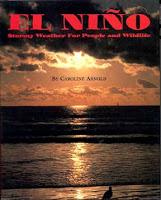 Beginnings: The beginning of your book creates the first impression. If you don’t grab your reader’s attention on the opening page, it doesn’t matter what else you say. In the opening of your book, you want to make the reader eager to find out more. At the same time you establish your tone, style and the level of complexity. You are telling the reader what to expect. There are many ways to start a book, but I like to set a dramatic scene that pulls the reader in and then tells what the book is going to be about. Here’s the beginning of my book, El Nino, Stormy Weather for People and Wildlife:
Beginnings: The beginning of your book creates the first impression. If you don’t grab your reader’s attention on the opening page, it doesn’t matter what else you say. In the opening of your book, you want to make the reader eager to find out more. At the same time you establish your tone, style and the level of complexity. You are telling the reader what to expect. There are many ways to start a book, but I like to set a dramatic scene that pulls the reader in and then tells what the book is going to be about. Here’s the beginning of my book, El Nino, Stormy Weather for People and Wildlife:For nine straight days in January 1995 rain poured down on the usually sunny state of California, causing floods, mud slides, and power outages. During the same period on the opposite coast flowers began to sprout, bears woke up from their winter naps, and people wore shorts as unusual springlike temperatures warmed the air. Both of these atypical weather events were due to El Nino, a powerful tropical ocean current that periodically disrupts weather all over the globe.
Endings: The final paragraph of the book is your opportunity to leave the reader with one last impression. Endings are always hard to write, but in the same way that the opening of the book told the reader what to expect, the ending tells the reader what he or she just learned. In all my books I like to end with a thought that places the topic of the book in a larger context. Here is the final sentence of El Nino:
As scientists find out about El Nino, La Nina, and the Southern Oscillation, they are learning how ocean warming that begins in the tropical Pacific is one of the most important keys to understanding the earth’s weather.
(El Nino: Stormy Weather for People and Wildlife (Clarion, 1996 and 2000) can be found in your library and online.)
